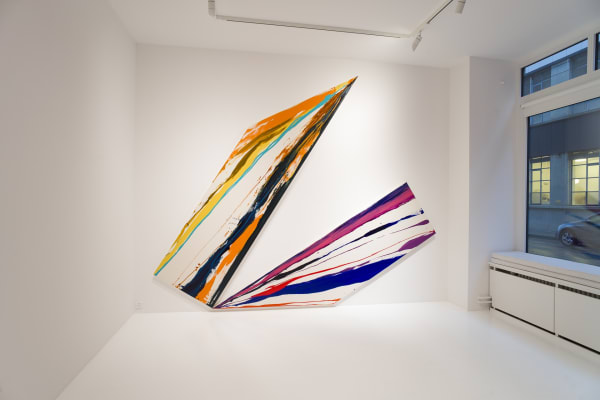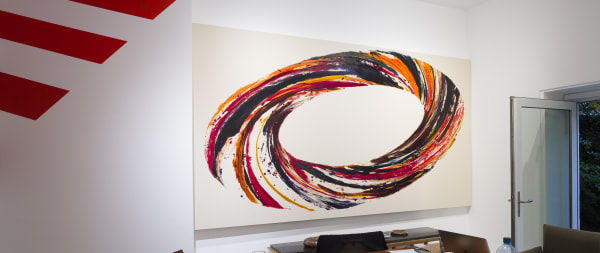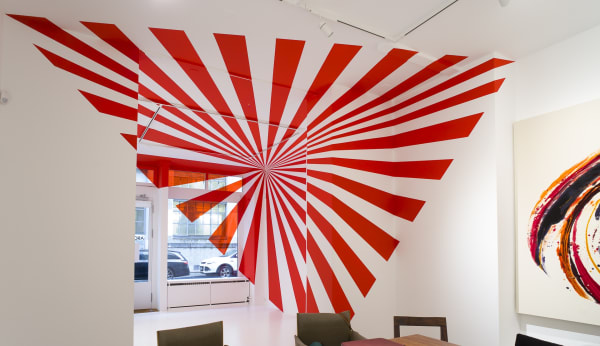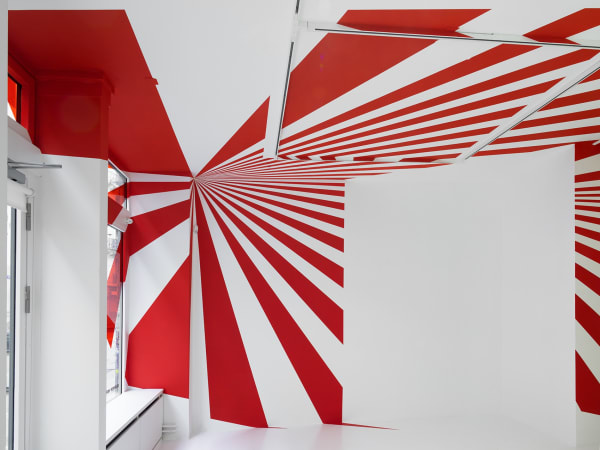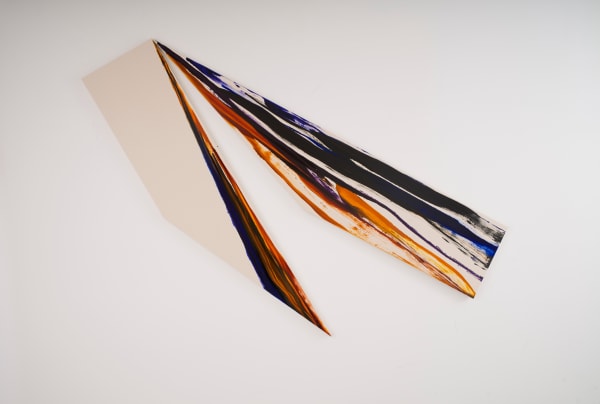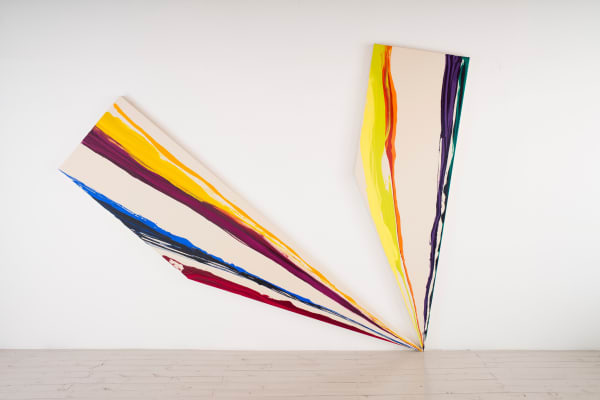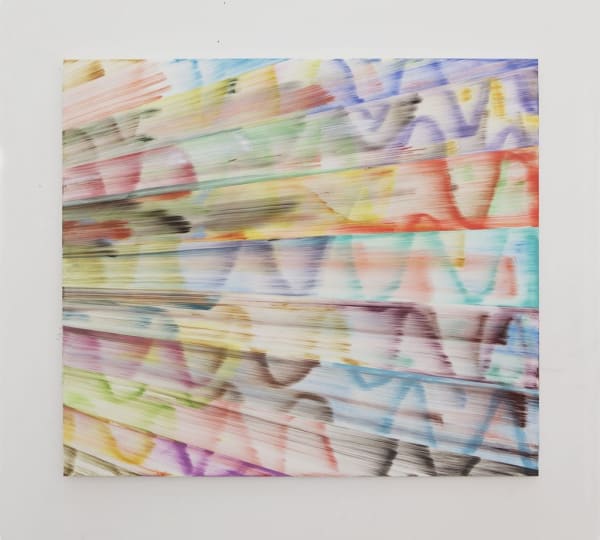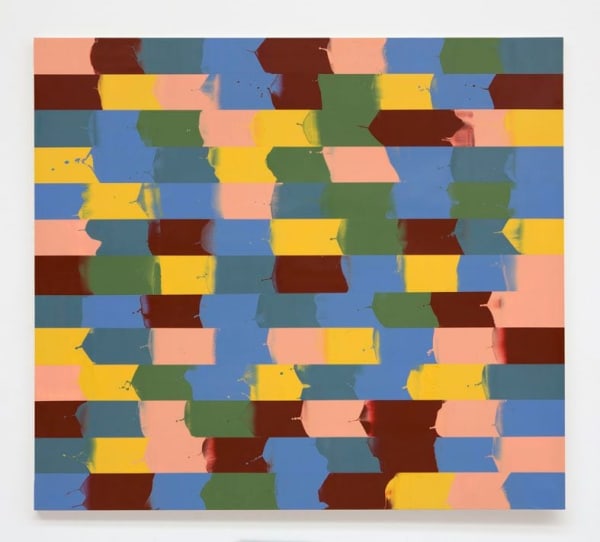Some perspectives on painting: Borgeaud - Frize - Varini: Geneva
-
 © Gregory Maillot point-of-view.ch
© Gregory Maillot point-of-view.ch -
 © Gregory Maillot point-of-view.ch
© Gregory Maillot point-of-view.ch -
 © Gregory Maillot point-of-view.ch
© Gregory Maillot point-of-view.ch -
 © Gregory Maillot point-of-view.ch
© Gregory Maillot point-of-view.ch -
 © Gregory Maillot point-of-view.ch
© Gregory Maillot point-of-view.ch -
 © Gregory Maillot point-of-view.ch
© Gregory Maillot point-of-view.ch -
 © Gregory Maillot point-of-view.ch
© Gregory Maillot point-of-view.ch -
 © Gregory Maillot point-of-view.ch
© Gregory Maillot point-of-view.ch -
 © Gregory Maillot point-of-view.ch
© Gregory Maillot point-of-view.ch -
 © Gregory Maillot point-of-view.ch
© Gregory Maillot point-of-view.ch -

-

-

-

-

-

-

-

-

-

-

-

-

-

-

-

-

-

-

-

-

-

-

-

-

-

Olivier Varenne Art Moderne & Contemporain presents Bernard Borgeaud in a group show with Bernard Frize, and Felice Varini – artists who both have also pushed visual and material boundaries in their careers. As summed up by Jean-Hubert Martin: “Single vanishing point perspective dominated painting from the Renaissance until the nineteenth century. The usual response of modernity has consisted of respecting the flatness of the support and not to try to create an illusion of space. These three painters offer new solutions to this question”.
Foreword by Jean-Hubert Martin, exhibition co-curator:
Single vanishing point perspective dominated painting from the Renaissance until the nineteenth century. The usual response of modernity has consisted conversely of respecting the flatness of the support and not to try to create an illusion of space. These three painters offer new solutions to this question.
The rejection of representation is the foundation of modern painting. The invention of perspective and its incredible ability to represent space on the painted surface has become so familiar to us that it passes for an achievement of value to all forms of art, whereas the opposite is true. The centuries of painting since the Renaissance are an exception in the History of Art. This type of visual belief has contributed to establishing both the hegemony of the West over the rest of the world and its mastery of nature. Even the Emperor of China called upon European Jesuits to depict his armies and his battles. A mimetic form of painting became the major artistic discipline, the other arts being relegated to the rank of applied arts or crafts. This taxonomy is unfortunately so rooted in our way of seeing that it hinders the development of a new discourse capable of encompassing the arts of all parts of the world.
By referring to all sorts of examples from other cultures, artists have, for a century, been constantly developing new paradigms to combat the idea that art can be reduced to the image of a view from a window. Two major routes then offered themselves to artists: either free themselves from painting and use other materials and other techniques, or remain faithful to painting and deepen its foundations. This last solution gave birth to abstract painting which itself split into a lyrical, expressionist path, and an analytical path which reflects on its bases and origins.
Three examples of the latter direction are shown here by three different artists: Bernard Borgeaud, Bernard Frize and Felice Varini.
Bernard Borgeaud reduces his reflection on painting to three fundamental elements: form, colour and gesture. He ends with Alberti’s window and its inseparable quadrilateral. The canvases are stretched on frames in elaborate shapes according to the desired objective. This creates a dynamic focal concentration, as if the reviled traditional perspective was represented by the direction of the coloured lines converging towards a putative eye. The conventional relationship between the painting and the wall intended to receive it is totally transformed. Instead of being in the middle of the wall, it rests partially on the ground. Colours carefully selected in advance from refined charts and diagrams, are then applied using gestures close to action painting, sometimes on segments determined by stencils.
The result allows a close link with the body and its even uncontrollable
movements, while the other parameters have been studied and matured at length. Order and chaos come together for a painting that above all is a testimony of vitality.
Through constantly renewed series Bernard Frize demonstrates the possibility of reducing materials, process and gesture to its simplest expression, without denying the appearance of a space or an image. He became a virtuoso at interlacing brush strokes with a single, uninterrupted charge of colour. The crossings and superpositions of these multicoloured lines become so complex and subtle that they raise questions about their technique of production. They have much to compare with the interlacing lettering of Irish manuscripts of the High Middle Ages. The conventions of realisation are the result of long reflections all trying to reduce the number of decisions to a minimum, totally opposite to abstract expressionism. This austerity does not prevent the sensory pleasure of colour and the appearance of images generated by the creative process, and gives way to phenomena or physical reactions that we qualify as chance.
Felice Varini makes use of single vanishing point perspective, but instead of using it to give depth to a flat image on canvas, he deploys it in space. He applies geometric shapes in and on architecture so that the figure is re-formed only when the eye is precisely at the location of the vanishing point. Reconnecting with the dialectic inherent in the art of order and chaos, Varini presents exploded and disorderly coloured forms that must be navigated and understood to seek the unique location at which the geometric form reconstitutes. His works are not so far removed from the exploration of anamorphosis so popular in the Renaissance. When he first imagined this process, he had no knowledge of it. Proof, if necessary, that artistic forms can reappear in different contexts, without there being contact and even less be influenced by the academic study of history of art.
Artist biographies:
BERNARD BORGEAUD (b. 1945)
Of Swiss heritage, Bernard Borgeaud was born in Paris where he has remained for much of his life. Painter, installation artist, performance artist and photographer he has held many cutting edge solo exhibitions, and exhibited in numerous group exhibitions internationally.
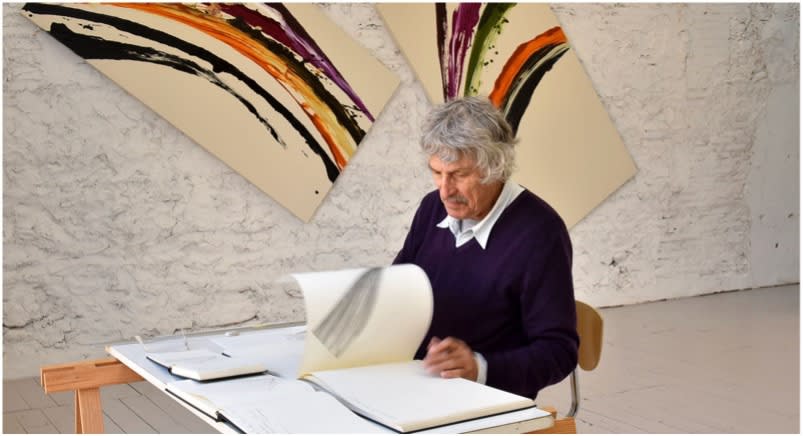
Form, perspective, definitions, limitations – were some of the preoccupations of artists of the second half of the twentieth century. Bernard Borgeaud is no different, yet, informed by his lifetime’s observations and experiences, bolstered by his History of Art studies, and hours spent in the Louvre, he has synthesized these concerns in a highly individual way, the recent culmination of which is a body of painted works.
FORCES OF NATURE AND JAZZ
An experience in his youth marked Borgeaud in a transformative way: “On a beach, the waves formed rollers a little higher than a man; risking myself there, I was dragged leg over head in a winding of a power that exceeded me so much that, in this abandonment of my body to this force... I experienced a feeling of infinity of a rare intensity... I repeated this experience dozens of times.”

FEU IV, 1971
Perhaps as a result of this experience, a theme which runs throughout his career is a desire to reveal the underlying energies at work in the four elements of nature - internal movements of the sea, transformations of bodies of water, the concentration and dispersion of light and fire. As with natural forces, listening to Jazz has provided Borgeaud with a source of inspiration. The rhythmic impulses of the body are comparable to the buffeting by the waves and resulting sense of freedom. It is no surprise therefore that gravity, and the way it effects the movement of the body in space, has also played a role in his recent painted works.
PHOTOGRAPHY
Photography was Borgeaud’s first chosen medium – “a compulsory modern means of making figurative images”. He took photographs of ephemeral installations and performances which he produced outdoors, and then presented in the form of image sequences. Two further essential notions emerged at this time which have remained consistent in his practice – scale and the body of the viewer. Furthermore, the many different viewpoints and absence of any centre in his photographic work allows the viewer to grasp the work in complete freedom - of vital importance for Borgeaud.
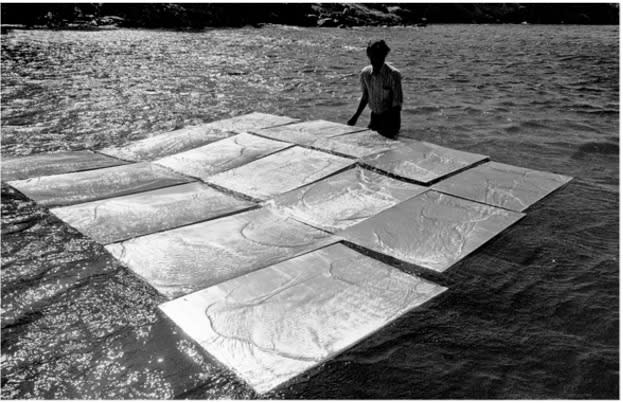
PLAQUES D'ALUMINIUM, 1969, EPHEMERAL INSTALLATION
His artistic career started with the 1969 exhibition Pläne und Projekte als Kunst put on at the Kunsthalle in Bern by legendary Swiss curator Harald Szeeman (1933-2005) and Zdenek Felix. Borgeaud was represented by his documentation for an ephemeral outdoor installation which consisted of shiny plates placed on the sea. An advocate of contemporary movements Szeemann developed a new form of exhibition-making that centred on close collaborative relationships with artists and a sweeping global vision of contemporary visual culture.
In 1970 Borgeaud had his first solo exhibition at the pioneering Ileana Sonnabend gallery in Paris. At the start of the 1970s, he frequented a small group of artists who gravitated around André Cadere, which included Annette Messager, Christian Boltanski, Jean Le Gac, Daniel Buren, Niele Toroni and Sarkis. From 1976, his work turned towards photographic installations which culminated in the late 1970s with very large works. During this period the Centre Pompidou in Paris acquired one of his works, and he was invited to participate in the Sydney Biennale and the Paris Biennale. In 1983 a large solo exhibition, Bernard Borgeaud: Nuits, was held at the Musée d’Art moderne de la Ville de Paris. The following year, the Kunsthalle in Bern put on an exhibition, Bernard Borgeaud: Vu, an important collection of his photographic works. His works entered public collections, and he continued to exhibit internationally.
PAINTING
From the 1990s to the present Borgeaud moved his focus to both monumental drawings and paintings which attest to his desire to “involve an act which was at once an intervention and a possession of reality, which faced the spectator by keeping to the wall, and holding the wall.” Exhibitions of these monumental works have included a solo exhibition at Ecole Nationale Supérieure des Beaux-Arts, Paris, an exhibition with Bernard Burkhard at Centre d'art contemporain - la synagogue de Delme (2000) and a group anniversary exhibition at the Domaine de Kerguéhennec (2016).

IMPRESSION N°1, 1994, RIGHT PART OF A DIPTYCH, OIL PASTEL ON ARCHES VELUM, 440 X 1800CM. EXHIBITED ÉCOLE NATIONALE SUPÉRIEURE DES BEAUX-ARTS, PARIS, 1994
SHAPED CANVAS
Borgeaud’s most recent exploration of form and surface through irregularly-shaped canvas can be seen to perpetuate the legacy of the geometric abstract artists of the late 1950s and early 1960s such as Frank Stella and Ellsworth Kelly. Their pushing the conventional boundaries of the canvas edge raised questions about a painting being an object in its own right – not as representative of something else, but a creation that blurred
the boundary between painting and sculpture.
Stella and Kelly each reacted against the expressive use of paint by Abstract Expressionist artists, and were drawn instead towards the “flatter” surfaces
of artists such as Barnett Newman, and the target paintings of Jasper Johns –
parallels to the latter works can be drawn in particular to later paintings by Borgeaud. It was in the 1950s that Stella epitomised this direction by stating that a picture is “a flat surface with paint on it – nothing more”. And in the 1960s Kelly’s first shaped canvases redefined painting’s figure/ground relationship and became a distinguishing feature of his subsequent practice.
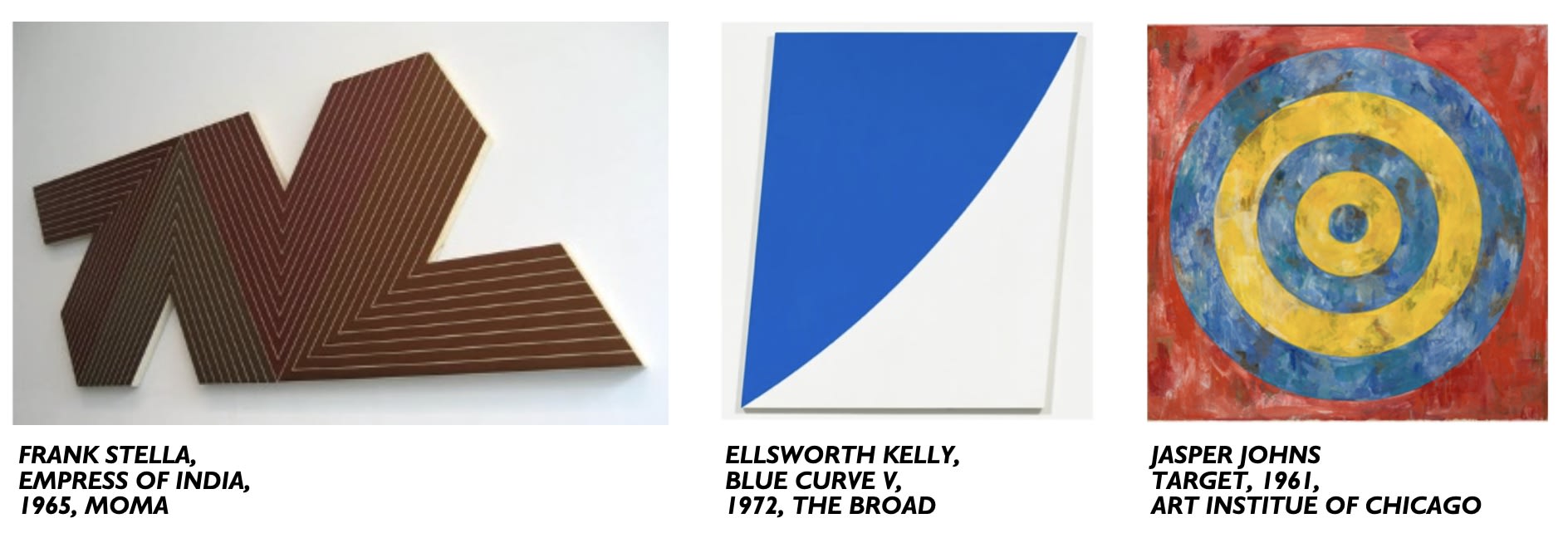
The balance of parts, and the importance and relationship of scale and dimension to the scale of the viewer are crucial to Borgeaud, as is the impact these elements have on the movement of the viewer’s body and eyes. He is inspired by how his art takes on a form and has an effect and life which is independent of his hand.
In his own words, Borgeaud’s work “stems from an externality. Its development requires the manipulation of processes and forces that must be triggered and led. A work is always a stand-alone object. A good work does not recount; it invests in the space definitively. There is no significance with art, only an object that presents itself to the viewer and opposes their charge.”
|
BORGEAUD SOLO EXHIBITIONS
|
|
1970: Galerie Ileana Sonnabend, Paris 1972: Galerie Yellow Now, Liège Interventions (with Jean Le Gac), Musée d’Art Moderne de la Ville de Paris Bernard Borgeaud et Paul-Armand Gette, Apeïros, Paris Cité Internationale de l’Université de Paris 1973: Galerie des Locataires/French Window, Paris Galerie Yellow Now, Liège (with Paul-Armand Gette) Les nuages blancs sont d’eux-mêmes des nuages blancs, Pont des Arts, Paris 1974: 2500 diapositives, La cour des miracles, Paris 1975: Musée National d’Art Moderne, Paris Installations Photographiques, Franklin Roosevelt metro station, Paris 1981: Maison de la Culture, Nevers Studio 666, Paris 1982: Exposition radiophonique, France Culture/Galerie des Locataires, Paris 1983: Nuits, ARC, Musée d’Art Moderne de la Ville de Paris 1984: VU, Kunsthalle, Berne L’origine des images, La Revue Parlée, Centre Georges Pompidou, Paris 1985: Architecture d’oubli, Maison Internationale, Rennes 1986: Sorte de surplomb, Galerie Arlogos, Nantes 1988: Galerie Nikki D. Marquardt, Paris Galerie Arlogos, Nantes 1989: CREDAC, Ivry-sur-Seine 1990: Ruimte Morguen, Anvers 1991: Maison de la Culture, Bourges Galerie Nikki D. Marquardt, Paris 1992: Galerie Art Attitude (with Emmanuel Saulnier), Nancy 1994: Ecole Nationale Supérieure des Beaux-Arts, Paris Galerie Art Attitude Hervé Bize, Nancy 1995: Galerie Arnaud Lefèbvre, Paris 1997: Galerie Art Attitude Hervé Bize, Nancy 1999: Galerie Edouard Manet, Gennevilliers Parc Saint-Léger, Centre d’art contemporain, Pougues-les-Eaux Musée des Beaux-Arts, Calais Hommage à Courbet, Musée des Beaux-Arts, Lons-le-Saunier 2000: Balthasar Burkhard et Bernard Borgeaud, La Synagogue de Delme, Centre d’art contemporain, Delme Musée des Beaux-Arts, Nancy; Galerie Art Attitude Hervé Bize, Nancy 2007: Galerie Philippe Pannetier, Nîmes 2010: Modèles d’espace, figures du temps, acb scène nationale, Bar-le-Duc From Point to Point gallery, Nîmes 2013: Galerie Hervé Bize, Nancy 2014: Peinture à plusieurs mains, Hôtel de Ville, Nancy 2016: Point de départ, Licence III, Perpignan |
|
BORGEAUD SELECTED GROUP EXHIBITIONS |
|
1969: Pläne und Projeke als Kunst, Kunsthalle, Berne 1970: Salon international des galeries pilotes (shown by Galerie Ileana Sonnabend) Musée d’Art Moderne de la Ville de Paris Boltanski, Borgeaud, Cadere, Le Gac, Sarkis, Tysh, American Center, Paris 1973: Information, Konsthallen, Sodertalje (Sweden) 1974: Art vidéo, ARC, Musée d’Art Moderne de la Ville de Paris 1975: Art vidéo, Palais des Beaux-Arts, Bruxelles 1979: Sydney Biennale Accrochage III, Galeries Contemporaines, Centre Pompidou, Paris 1980: Il nuovo contesto in Europa, Studio Marconi, Milan 1981: Sélection de la XIe biennale de Paris, Sara Hilden Art Museum, Tampere, Finlande 1982: L’année littéraire de Marcelin Pleynet, ARC, Musée d’art Moderne de la Ville de Paris 1984: Situation 1, Centre d’Art Contemporain, Orléans 1985: Alles und noch viel mehr, Kunstmuseum et Kunsthalle, Berne 1986: Territoire photographique, géographie photographiée, Musée de Chartres 1987: Un aspect des collections du FRAC Centre, Centre Régional d’Art Contemporain, Châteauroux 1988: Art pour l’Afrique, Musée National des Arts d’Afrique et d’Océanie, Paris La photographie et le photographique, Musée d’Art Moderne de la Ville de Paris 1989: Fonds National d’Art Contemporain, acquisitions 1988, CNAP, Paris 1991: Lato sensu, travelling exhibition: Copenhagen, Hamburg, Fribourg. 1992: Hommage à André Caderé, Musée d’Art Moderne de la Ville de Paris 1994: Restauration, Galerie Art Attitude Hervé Bize, Nancy 1995: La bataille de Nancy, Galerie Art Attitude Hervé Bize, Nancy Oeuvres récentes, Galerie Art Attitude Hervé Bize, Nancy Kitakanto Museum, Maebashi, Japan 1996: Another Photography, Metropolitan Museum of Photography, Tokyo 1997: 5 ans d’acquisitions, FRAC Alsace, FRAC, Sélestat et CEAAC, Strasbourg 2000: Réalités (Hommage à Courbet), Le 19, Centre d’Art Contemporain, Montbéliard 2002: Réalités (hommage à Courbet), Centre d’art Passerelle, Brest Circonstances, Galerie Art Attitude Hervé Bize, Nancy 2004: Intimes convictions, Galerie Art Attitude Hervé Bize, Nancy 2006: Bernard Borgeaud, Arnaud Claass, Emmanuel Saulnier, Galerie Art Attitude Hervé Bize, Nancy 2008: André Cadere, peinture sans fin, Musée d’Art Moderne de la Ville de Paris 2009: Keep your options open, 1989-2009, Galerie Art Attitude Hervé Bize, Nancy 2010: Explorations, Galerie Art Attitude Hervé Bize, Nancy 2011: Drawing Now, Salon du dessin contemporain, Paris Cabin : codex, from feral to urban, from codex to artists' book, DJCAD, Dundee Contemporary Arts, Dundee 2013: La fabrique des possibles, commissaire Pascal Neveux, FRAC Provence, Alpes Côte d'Azur, Marseille 2015: Vertizontal, Galerie Hervé Bize, Nancy 2016: Paysages contemporains, Domaine de Kerguéhennec 2018: In Side Out, Galeria Horizon, Colera, Espagne 2020: L’esprit du lieu, Musée Hyacinthe Rigaud, Perpignan |
|
PUBLIC COLLECTIONS |
|
|
Musée National d’Art Moderne, Centre Pompidou, Paris (2 works) Fonds National d’Art Contemporain, Paris (5 works) Cité des Sciences et de l’Industrie Musée d’Art Moderne de la Ville de Paris (2 works) Musée Municipal, La Roche-sur-Yon Musée des Beaux-Arts, Nancy FRAC Alsace FRAC Bourgogne FRAC Bretagne (2 works) FRAC Centre FRAC Pays de la Loire FRAC Lorraine (2 works) FRAC Haute-Normandie acb Scène nationale, Bar-le-Duc Kunstmuseum, Berne |
|
-
 Bernard Borgeaud, 2020.4, 2020
Bernard Borgeaud, 2020.4, 2020 -
 Bernard Borgeaud, 2020.6, 2020
Bernard Borgeaud, 2020.6, 2020 -
 Bernard Borgeaud, 2020.9, 2020
Bernard Borgeaud, 2020.9, 2020 -
 Bernard Borgeaud, 2023.2, 2023
Bernard Borgeaud, 2023.2, 2023 -
 Bernard Borgeaud, 2015.10, 2015
Bernard Borgeaud, 2015.10, 2015 -
 Bernard Borgeaud, 2015.11, 2015
Bernard Borgeaud, 2015.11, 2015 -
 Bernard Borgeaud, Abîme-Mains, 1984
Bernard Borgeaud, Abîme-Mains, 1984 -
 Bernard Borgeaud, Attentes, 1985
Bernard Borgeaud, Attentes, 1985 -
 Bernard Borgeaud, Croisés, 2003
Bernard Borgeaud, Croisés, 2003 -
 Bernard Borgeaud, Etoile, 1984
Bernard Borgeaud, Etoile, 1984 -
 Bernard Borgeaud, Ouvrir, 2003
Bernard Borgeaud, Ouvrir, 2003 -
 Bernard Borgeaud, Page de Carnet, 2002-2003
Bernard Borgeaud, Page de Carnet, 2002-2003 -
 Bernard Borgeaud, Sur l'album rouge, 2003
Bernard Borgeaud, Sur l'album rouge, 2003 -
 Bernard Frize, Era, 2013
Bernard Frize, Era, 2013 -
 Bernard Frize, Mourdi, 2009
Bernard Frize, Mourdi, 2009 -
 Bernard Frize, Suite à Onze n°20, 2006
Bernard Frize, Suite à Onze n°20, 2006 -
 Felice Varini, Quadrilatère d'arcs et de cercles, bleu, noir, rouge, jaune, 2015
Felice Varini, Quadrilatère d'arcs et de cercles, bleu, noir, rouge, jaune, 2015











